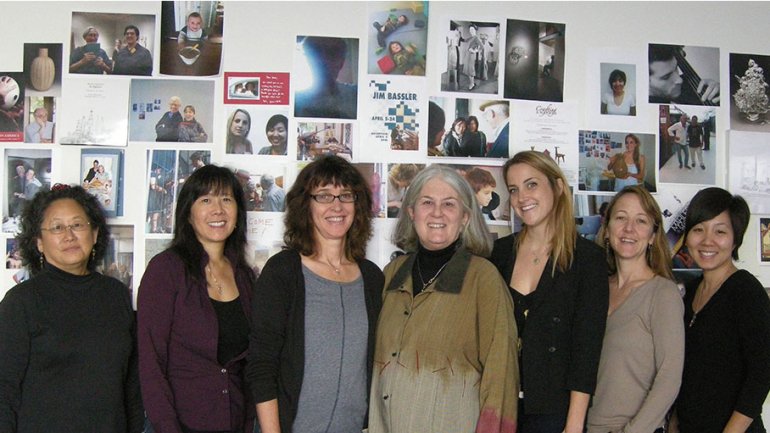Craft in America: Behind the Scenes in Los Angeles
Carol Sauvion [“The Journey So Far,” Apr./May 2014] may be the visionary and driving force behind Craft in America, but as she stresses often, the project is a collaboration of many people, from the small, close-knit staff and film crew to a wide-ranging network of supporters. This is apparent at the Craft in America Center and the film production office. At both, the atmosphere is warm and familial, with a palpable sense of mission.
“Carol plants the seeds, gives us the perfect balance of ‘let's do it this way’ versus ‘take it away and make it happen,’ with that constant, undying perseverance that is really inspiring,” says Emily Zaiden, director of the Craft in America Center. The storefront space opened in 2009 and “sort of has become a mini-museum or micro-museum, or at least that’s what we aspire to,” Zaiden says. Along with exhibitions (either directly tied to show episodes or exploring such themes as the relationship of craft and food), the center hosts lectures and workshops and is home to a growing library of books, magazines, and rare primary source materials, plus raw, unused film footage from the series – all of it available to the public.
Zaiden’s pet project these days is a new partnership with Fairfax High School, a visual arts magnet in the heart of L.A., designed to bring craft artists into the classroom and students into the center. “The focus is to give students direct exposure to the work, and to how artists make careers at art,” she says. It’s an important step toward the larger goal of Craft in America: to encourage and inspire would-be makers at every level. So far, participants have included ceramist Jeff Oestreich, illustrator J.T. Steiny, and glass artist Paul Marioni, as well as Hidde Van Duym, a collage artist and arts administrator.
Van Duym was the first board president of the Craft in America organization and remains a close advisor. He recently led a weekend workshop at the center that brought together a diverse group, from a retired architect to a pair of teenaged sisters. The two girls, he says, “were from a home where none of this [exposure to art] takes place. Their parents are working 12 hours a day, and there’s never any time.” Young people like these are exactly the audience the Fairfax High program is intended to reach, he says. “It’s a major experience for these kids, I'm sure of that. It’s very clear they are lifted out of something, towards meeting professional people. That’s terrific for them, that they are given this opportunity, hands-on.”
Van Duym lives on Bainbridge Island, WA, and first became captivated by craft when he saw the landmark exhibition “Objects USA” on its late 1960s - early ‘70s tour. “It was absolutely a transformer for me, because I realized what people could do with materials.” Getting involved with Craft in America rekindled that excitement for him. “It keeps opening my world. I may have given something, but I'm receiving a lot more.”
Pat Bischetti, the senior producer of the Craft in America TV series, has had a distinguished 30-year career making documentaries for Discovery, National Geographic, and other channels. “This is the one project in my career that I’ve been doing consistently, since 2006,” she says. “We are really a family, working with a small core group of people. We’re very collaborative. From the beginning, we talk about what stories to follow and why, how they all work thematically.”
Last year Bischetti convened a blue-sky meeting for the Craft in America team. “We were at a point where we wanted to look at what we’ve achieved, where we've arrived, and really think through where we want to take it from here. It helped to set goalposts for where we want to go.” (Sauvion, for her part, is determined that the organization thrives in perpetuity.)
“One of the things we identified was that we feel we’re a gateway to craft for the general public, here to provide inspiration. Airing on PBS is important to us, so that everyone can access our programs,” Bischetti says. “We were also very inspired by our Craft in America Center. We see that as a community builder, and we’d like to eventually see the idea expand to other cities.”
Craft in America’s website and social media presence are increasingly key to its educational mission. Web content “creates a bridge,” enabling viewers of the TV series to hop online, learn about a craft, and maybe try it themselves, Bischetti says. At the meeting, “We spent a lot of time with our younger assistant editor, who is of that generation that doesn’t next necessarily watch TV as much as [older people] do. Their whole world is social media. It was an inspired part of our discussion, where we talked about how younger people are engaging, how there is a true interest in the handmade among their generation. And how easy it is to see what your interest is, in a heartbeat, on the Internet, and pursue it.”
Over at the production office, Emily-Rose Wagner is the 20-something assistant editor to whom Bischetti refers. Wagner says: “A lot of my friends – I'd say 9 out of 10 – don't have TV. Cable is expensive, and you can watch most stuff online for a lot cheaper. So they just stream things from the Internet to the television.” One of Wagner’s tasks is editing clips for the website, including how-to shorts. “It's something I was interested in doing, because that's my main reason for going online and looking at videos,” she says and mentions a papier-mâché ornament she’d recently made after watching a demo on YouTube.
I ask Wagner how people her age react to the series. “It tells you that you can go out there and do this, and make a living at it,” she says. “I think it's a constant struggle to try and figure out what you want to do, and be happy doing it. So it's exciting to see the people on Craft in America succeeding. …I have tons of friends who have Etsy stores and have quit their [day] jobs and are trying to do something. Or they’re doing their job and something on the side, and hoping that picks up. They’re starting their own companies, like an artisan popsicle company.”
Like Sauvion, who is a potter, it turns out that many members of the Craft in America team do handwork in their spare time. “I craft out of necessity,” says associate producer Denise Kang. “If I need something and can’t buy it, or nobody makes it the way I want it, then I need to make it. My bag that I loved for so long was falling apart, so I just made another one. I made my boyfriend's Halloween costume.” Kang maintains the Craft in America archives and manages its Facebook page, Twitter account, and YouTube channel. Lately, she’s been going on the road with Sauvion and the film crew to assist on location shoots all over the country. “What’s really great about filming craftspeople is that their homes are wonderfully decorated,” she says. “The challenge is just making sure everything comes together at the right time and place.”
In another room of the production office, film editor Beth Spiegel looks at a rough cut of the latest episode, “Industry: Handmade in the Creative Economy.” Spiegel works with the Craft in America producers to select and assemble scenes from hours of footage shot by Chicago-based cinematographer Sidney Lubitsch. (Music composer Laura Karpman is also involved from early on, to score each episode.)
“These are portraits. So there’s always the personal story, and then how that is interwoven into what the artist does. I don't think of these as how-to shows, but at the same time you want to get the essence of the craft,” says Spiegel. Each maker is unique, she adds, and so is every locale, requiring various visual styles. For Tanya Aguiñiga, a wildly creative Mexican-American textile artist and activist, the look was “colorful and chaotic, in the best way.” Lia Cook, a San Francisco weaver whose work combines old and new technologies, called for an “edgy and smart” presentation. For Midwestern potters Warren MacKenzie, Jeff Oestreich and Clary Illian, the mood was “lyrical,” while New York metal sculptor Albert Paley inspired a faster pace with high energy with lots of jump cuts.
A weaver and printmaker herself, Spiegel loves those moments Lubitsch captures with his camera. “A lot of the processes are so cinematic, meaning conveyed well in film. Being able to watch something like a pot coming up on the wheel, or silver being pounded and molded into a spoon, is just amazing.”
Finally, producer Rosey Guthrie speaks of how the show illuminates the power of craft as carrier of culture and vehicle for social commentary. She points to various moments in the series: Dr. Leslie King-Hammond talking about the legacy of slavery and the importance of holding onto traditional crafts when all else is lost and broken; Army veteran Tom Pullin reflecting on his time in Iraq and how working in metal has helped him heal; weaver Randall Darwall and designer Brian Murphy mentioning their marriage, which they won’t truly celebrate until same-sex marriage is legal everywhere.
“There’s a real American history in every one of these episodes,” Guthrie says. “Industry,” for example, takes us to the Lowell Boat Shop in Amesbury, Massachusetts, where wooden boats have been made by hand since 1793. “But we’re also open to the new, like Shane Yamane, the Etsy jewelry artist we’re profiling. He’s concerned with ethically sourced diamonds. It’s that kind of consciousness that is showing up in these stories, covering the issues of the day. Craft is a very relevant art form.”
Joyce Lovelace is American Craft’s contributing editor. Read her extended interview with Craft in America’s Carol Sauvion from the Apr./May issue.




